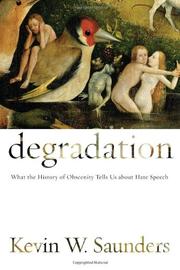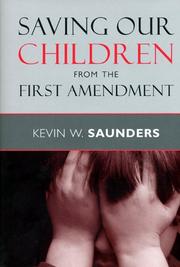| Listing 1 - 5 of 5 |
Sort by
|

ISBN: 0822317672 0822398923 0822317583 1322141304 Year: 1996 Publisher: Durham : Duke University Press,
Abstract | Keywords | Export | Availability | Bookmark
 Loading...
Loading...Choose an application
- Reference Manager
- EndNote
- RefWorks (Direct export to RefWorks)
This timely and accessible volume takes a fresh approach to a question of increasing public concern: whether or not the federal government should regulate media violence. In Violence as Obscenity, Kevin W. Saunders boldly calls into question the assumption that violent material is protected by the First Amendment. Citing a recognized exception to the First Amendment that allows for the regulation of obscene material, he seeks to expand the definition of obscenity to include explicit and offensive depictions of violence.Saunders examines the public debate on media violence, the arguments of professional and public interest groups urging governmental action, and the media and the ACLU’s desire for self-regulation. Citing research that links violence in the media to actual violence, Saunders argues that a present danger to public safety may be reduced by invoking the existing law on obscenity. Reviewing the justifications of that law, he finds that not only is the legal history relied on by the Supreme Court inadequate to distinguish violence from sex, but also many of the justifications apply more forcefully to instances of violence than to sexually explicit material that has been ruled obscene. Saunders also examines the actions that Congress, states, and municipalities have taken to regulate media violence as well as the legal limitations imposed on such regulations by the First Amendment protections given to speech and the press. In discussing the current operation of the obscenity exception and confronting the issue of censorship, he advocates adapting to the regulation of violent material the doctrine of variable obscenity, which applies a different standard for material aimed at youth, and the doctrine of indecency, which allows for federal regulation of broadcast material.Cogently and passionately argued, Violence as Obscenity will attract scholars of American constitutional law and mass communication, and general readers moved by current debates about media violence, regulation, and censorship.
Mass media --- Violence in mass media --- Obscenity (Law) --- Freedom of the press --- Law and legislation
Book
ISBN: 9780814739938 Year: 2003 Publisher: New York, NY
Abstract | Keywords | Export | Availability | Bookmark
 Loading...
Loading...Choose an application
- Reference Manager
- EndNote
- RefWorks (Direct export to RefWorks)

ISBN: 9780814708750 0814708757 9780814741450 0814741452 Year: 2010 Publisher: New York : New York University Press,
Abstract | Keywords | Export | Availability | Bookmark
 Loading...
Loading...Choose an application
- Reference Manager
- EndNote
- RefWorks (Direct export to RefWorks)
Throughout history obscenity has not really been about sex but about degradation. Sexual depictions have been suppressed when they were seen as lowering the status of humans, furthering our distance from the gods or God and moving us toward the animals. In the current era, when we recognize ourselves and both humans and animals, sexual depiction has lost some of its sting. Its degrading role has been replaced by hate speech that distances groups, whether based on race, ethnicity, gender, or sexual orientation, not only from God but from humanity to a subhuman level. In this original study of the relationship between obscenity and hate speech, First Amendment specialist Kevin W. Saunders traces the legal trajectory of degradation as it moved from sexual depiction to hateful speech. Looking closely at hate speech in several arenas, including racist, homophobic, and sexist speech in the workplace, classroom, and other real-life scenarios, Saunders posits that if hate speech is today’s conceptual equivalent of obscenity, then the body of law that dictated obscenity might shed some much-needed light on what may or may not qualify as punishable hate speech.
Law --- Hate speech --- Hate speech. --- Obscenity (Law) --- Pornography.

ISBN: 0814739938 0814740359 0814786936 0814798357 1417568496 Year: 2003 Publisher: NYU Press
Abstract | Keywords | Export | Availability | Bookmark
 Loading...
Loading...Choose an application
- Reference Manager
- EndNote
- RefWorks (Direct export to RefWorks)
Book
ISBN: 0199996849 9780199996841 129995636X 9781299956360 9780199916269 0199916268 Year: 2013 Publisher: New York : Oxford University Press,
Abstract | Keywords | Export | Availability | Bookmark
 Loading...
Loading...Choose an application
- Reference Manager
- EndNote
- RefWorks (Direct export to RefWorks)
For the first time, Oxford University Press equips students with an accessible guide to exercising their understanding of the fundamental law of the United States on law school exams. In Constitutional Law: Model Problems and Outstanding Answers, Kevin Saunders and Michael Lawrence help students demonstrate their knowledge of constitutional law in the structured and sophisticated manner that professors expect on law school exams. The book provides clear introductions to major topics in constitutional law, provides hypotheticals similar to those that students can expect to see on an exam, including multi-issue questions, and offers model answers to those hypotheticals. Professors Saunders and Lawrence then also coach students in how to evaluate their own work with a comprehensive self-analysis section. This book prepares students by challenging them to use the law they learn in class while also explaining the best way to express an answer on law school exams.
| Listing 1 - 5 of 5 |
Sort by
|

 Search
Search Feedback
Feedback About UniCat
About UniCat  Help
Help News
News